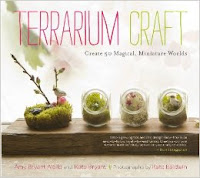As a teacher, I am always encouraging my students to read more non-fiction. Recently, I decided I ought to take my own advice and move away from my go-to mysteries. As I pondered what non-fiction area to delve into, I thought back to my childhood and remembered the times spent at camp making terrariums with my aunt. She patiently and carefully showed me what to do and we got busy collecting items for our terrariums. These fond memories sparked my interest and I decided to do some research into terrariums.
I started looking on Minerva, the electronic “card catalog” and I found two great books. Basically, a terrarium is a miniature world in a glass environment. It usually contains a bed of small rocks, moss, and various tiny plants. You can add minerals, sea glass, and even a tiny gnome.
Terrarium Craft : create 50 magical, miniature worlds by Amy Bryant Aiello & Kate Bryant ; photography by Kate Baldwin.
This book had lots of tips about how to create a terrarium, what to include, and the various materials and tools needed.
The New Terrarium : Creating Beautiful Displays for Plants and Nature By Tovah Martin ; photographs by Kindra Clineff.
This book had lots of great ideas on creating beautiful displays.
Caring for a live moss terrarium is fairly easy. All mosses need to be in filtered or dappled light, but should never be in direct sunlight. Even artificial light will work fine. Containers should have a lid unless the opening is very small. A light misting from a spray bottle is required approximately every two to four weeks. Condensation is not uncommon but may be a sign that the terrarium is getting too much sun or temperature fluctuation. If the moss is dry to the touch, give it a good misting, leave the lid off for about an hour to let the moisture evaporate, then move it to a shadier spot.
Terrariums are relatively self-sustaining ecosystems that generally need limited care. Remember to keep the glass clean for better viewing!
Sarah Duffy, Library Assistant


